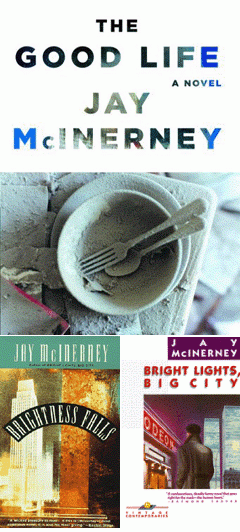Perhaps no single book details the excesses of the 1980s—in particular the debauchery of the New York City social scene—better than Jay McInerney’s Bright Lights, Big City (Vintage Books, 1984). The author’s commercially successful debut novel was adapted into a movie, starring Michael J. Fox and Keifer Sutherland, in 1988.

Bright Lights, Big City was followed quickly by two more books, Ransom (Vintage, 1985) and Story of My Life (Random House, 1988), but it wasn’t until the critical success of McInerney’s fourth, Brightness Falls (Knopf, 1992), that the author proved himself to be more than a one-hit wonder.
In the fourteen years since then, McInerney has published three more books—the novel Last of the Savages and the short story collection Model Behavior, both released by Knopf, and a book on wine, Bacchus and Me: Adventures in the Wine Cellar (Lyons Press, 2002).
A student of Raymond Carver (king of realism, some have said), and the contextual descendent of F. Scott Fitzgerald, (king of the party, some have said), there has always been an inherent duality in McInerney’s writing. His tales of excess are countered by characters that have a desire to be a part of the typical American family—picket fence, children, dog, and so on—but this dream remains just out of reach. It has been a hard course to follow for McInerney in his own life as well. “I’m a veteran of failed marriages,” he says.
McInerney’s new novel, The Good Life, published this month by Knopf, returns to the characters of Brightness Falls and chronicles their lives in New York City during the days and months following 9/11.
P&W: How long did you work on The Good Life?
Jay McInerney: Three and a half years, three drafts. The opening section, “Indian Summer,” I had been toying around with, returning to characters in Brightness Falls, similar to what John Updike does with the Rabbit character, or what Ford or Philip Roth have done. Then 9/11 happened.
P&W: What did you see on 9/11?
JM: I watched the whole thing out of my window. As I pulled my shade up in the morning, I saw the first plane crash into the World Trade Center out of the corner of my eye. I saw it all unfold. I kept turning from the TV to my window. It was completely surreal. I tried to go down there but it was blocked off. I did end up working in a soup kitchen, trying to help, for two months, like the characters Luke and Corrine in the new novel.
P&W: Did you have any hesitations in writing about 9/11?
JM: Yes, a lot. Norman Mailer told me to wait at least ten years to write about it. He said I needed time to process, distance. It was too late though. I had already started. There was a time right after 9/11 when all of us [New Yorkers] said things would never be the same—I’m not sure that is true. But I didn’t want to lose that initial feeling. I wanted to capture the mood of the first three months past 9/11, before it faded, the hundred-thousand-plus individual acts of random kindness and charity. New Yorkers shed their shells for a while—people were extraordinary. And it was wild. There was a wartime atmosphere, waiting for the next shoe to drop. Anthrax was being delivered to buildings. There was an incredibly heightened reality and consciousness. I didn’t want that to fade.
P&W: Are you concerned that some people might question writing fiction about 9/11?
JM: I’m not afraid of nasty reviews. I’ve been panned everyway possible. What I am concerned about is that it was an overwhelming subject. The balance of writing about the tragedy as it intermixed with the characters and their needs. But, essentially, I had to face it. As a New Yorker, it is always a shadow in the background. Dealing with the significance of it. … I’m a New York writer. It’s what I write about.
P&W: There is a more formal structure in The Good Life, each chapter rotates between two characters’ points of view. Did you outline this book purposely?
JM: Outlines aren’t useful for me. I have friends that use outlines well. For me, I have to be engaged with the language. The character has to develop and grow on his own—a discovery. E.L Doctorow said writing a novel is like driving across country at night. You can only see as far as the headlights, but you can make the whole journey that way. I subscribe to that a bit.
P&W: Bret Easton Ellis and you are often mentioned in the same breath when writing careers are brought up. There has been character swapping between some of your individual books—and in Ellis’s Lunar Park you are a full-blown character.
JM: I loved Lunar Park, thought it was great. And Bret is one of my best friends. A lot of this started with a character of mine from The Story of My Life who shows up in American Psycho by Bret. It should be noted that Bright Lights, Big City came out before Less Than Zero. The whole thing is amusing and fun. I had the first … party for Bret in New York for Less Than Zero.
P&W: What are you currently working on?
JM: Another novel. It’ll come out a lot sooner than the gap between Model Behavior and The Good Life.







